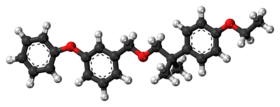Etofenprox
 | |
 | |
| Names | |
|---|---|
| IUPAC name
2-(4-ethoxyphenyl)-2-methylpropyl 3-phenoxybenzyl ether | |
| Other names
Ethofenprox, MTI-500, Trebon | |
| Identifiers | |
| 80844-07-1 | |
| 3D model (Jmol) | Interactive image |
| ChEBI | CHEBI:39348 |
| ChEMBL | ChEMBL2105573 |
| ChemSpider | 64377 |
| ECHA InfoCard | 100.100.942 |
| KEGG | D09202 |
| PubChem | 71245 |
| UNII | 0LD7P9153C |
| |
| |
| Properties | |
| C25H28O3 | |
| Molar mass | 376.488 |
| Appearance | white (pure) or amber (man.) |
| Density | 1.172 g/cm3 at 20.7 °C ± 0.1 °C |
| Melting point | 37.4 °C (99.3 °F; 310.5 K) |
| Boiling point | degradation at about 200 °C |
| Hazards | |
| Flash point | > 110 °C (230 °F; 383 K) |
| Except where otherwise noted, data are given for materials in their standard state (at 25 °C [77 °F], 100 kPa). | |
| | |
| Infobox references | |
Etofenprox is a pyrethroid derivative which is used as an insecticide. [1] Mitsui Chemicals Agro Inc. is the main manufacturer of the Chemical.
Also found as an ingredient in flea medication for cats.
Hazards to Humans & Domestic Animals
Harmful if swallowed. Causes moderate eye irritation. Avoid contact with eyes, skin or clothing. Repeated exposure to etofenprox can cause skin irritation. [2] Acute oral, rat, LD50 >2000 mg/kg. Acute dermal, rat LD50 >2000 mg/kg. Acute inhalation, rat LC50 >5.88 mg/l. Skin irritation, rabbit non-irritant. Eye irritation, rabbit non-irritant. Skin sensitization, intradermal and topical, guinea pig, non-sensitizer. [3]
Environmental Hazards
This pesticide is toxic to aquatic organisms, including fish and aquatic invertebrates. Runoff from treated areas or deposition into bodies of water may be hazardous to fish and other aquatic organisms. Etofenprox is highly toxic to bees exposed to direct treatment on blooming crops or weeds. Time applications to provide the maximum possible interval between treatment and the next period of bee activity. [4]
Environmental persistence
Etofenprox is decomposed in soil by anaerobic and aerobic microorganisms. In sterilized soil little degradation took place in a 56-day test.[5] Photochemical oxidative degradation is rapid, in air the half life is estimated at 2.07 hours. The principle metabolites do not accumulate and degrade to CO2, half-life is between 14-44 days. Etofenprox itself degrades in 7 to 45 days depending on soil and temperature.[6]
Physical/Chemical Hazards
Combustible. Do not use or store near heat or open flame. [7]
General uses
Etofenprox is an insecticide, which disturbs insect nervous systems following direct contact or ingestion, and which is active against a broad spectrum of pests. It is used in agriculture, horticulture, viticulture, forestry, animal health and public health against many insect pests, for instance Lepidoptera, Hemiptera, Coleoptera, Diptera, Thysanoptera and Hymenoptera. In agriculture, etofenprox is used on a broad range of crops such as rice, fruits, vegetables, corn, soybeans and tea. It is poorly absorbed by roots and little translocation occurs within plants. In the public health sector, etofenprox is used for vector control either by direct application in infested areas or indirectly by impregnating fabrics, such as mosquito nets. Etofenprox is used at low volumes to control adult mosquitoes, non biting midges, biting and non-biting flies. Etofenprox is used undiluted for ultra low volume aerosol applications or diluted with a diluent such as mineral oil for direct applications, for the control of pest species in or near residential, industrial, commercial, urban, recreational areas, woodlands, golf courses, and other areas where these pests are a problem.
References
- ↑ Becker, Norbert; Petric, Dusan; Zgomba, Marija; Boase, Clive (2010). Mosquitoes and Their Control. Springer. p. 463. ISBN 978-3-540-92873-7. Retrieved 2011-04-13.
- ↑ {{US Environmental Protection Agency "US EPA, Pesticide Product Label, RF2146 RTU, 11/18/2013" | accessdate =2014-05-21}}
- ↑ World Health Organization WHO SPECIFICATIONS AND EVALUATIONS FOR PUBLIC HEALTH PESTICIDES ETOFENPROX
- ↑ {{url2 = "US EPA, Pesticide Product Label, RF2146 RTU, 11/18/2013" | accessdate =2014-05-21}}
- ↑ Aerobic versus Anaerobic Microbial Degradation of Etofenprox in a California rice field soil, Department of Environmental Toxicology, College of Agriculture and Environmental Sciences, University of California.
- ↑ European Chemical Agency, Risk Assessment RAC
- ↑ {{US Environmental Protection Agency "US EPA, Pesticide Product Label, RF2146 RTU, 11/18/2013" | accessdate =2014-05-21}}